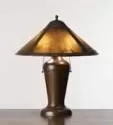Book Review: Bay Area Copper, 1900-1950

Bay Area Copper, 1900-1950: Dirk van Erp and His Influence
Gus Bostrom
California Historical Design, Publisher
(118 pages, color photography, $40)
“Initially,” Gus Bostrom stated, “I was a bit intimidated by the idea of organizing a comprehensive show on Bay Area copper. I wanted to do the show, but I did not want to write the book. I had never written a book before.”
For someone who had never written a book before now, let alone considered publishing it himself, Gus Bostrom has put aside any doubts as to his ability to organize, research and present his information in a concise, authoritative and valuable Arts and Crafts reference book.
From the attractive wrap-around cover to the quality paper and inviting layout, this book evokes ‘class.’ It is that rare combination of a book large enough and professional enough to lay atop your Arts and Crafts sideboard, while at the same time being a book that I literally could not put down until I had finished reading it in its entirety.
The author’s writing style is direct and concise. He does not encumber his text with rambling discourse or superfluous descriptions that too often force a reader to hunt for the point the author is trying to make. Knowing full well that he is not known as a scholar in the Arts and Crafts field, Bostom is careful to document his findings with footnotes and extensive quotes from original material, some of which had never been previously published.
The book is amply illustrated with a near-perfect combination of historic pictures, color photographs, and identifying shopmarks in a layout that is easy to read and, just as important, easy to navigate when you are flipping through it looking for a particular craftsman or craftswomen.
I mention the latter because Bostrom reveals for us the fact that women played a key role in Bay Area Arts and Crafts beyond that of D’Arcy Gaw and Agatha van Erp. A photograph taken around 1915 in Agatha van Erp’s classroom shows one young man and three women meticulously hammering out their copper bowls, bookends and mica lamp bases. Bostrom also introduces us to Ruth Strensrud, an attractive young metalsmith who worked alongside the men in the van Erp workshop.
And if you are thinking this is going to be a book just about van Erp lamps, you will be pleasantly surprised at how little of the text and how few of the photographs are focused on van Erp’s lamps. Instead, Bostrom delves into areas of van Erp’s career that until now had only received passing attention, in particular his earliest years when van Erp was transforming brass military shell casings into vases and bowls.
Bostrom also devotes more than half of the book to those craftsmen and craftswomen in the San Francisco area who have been obscured by the large shadow cast by van Erp amid contemporary histories of the Arts and Crafts era. Bostrom has tracked down family photographs and documents that shed light on such little known craftsmen and firms as Fred Brosi, two Harry Dixons, Digby Brooks, John Willocx (the actual Flemish spelling of Willcox), and the B & M Shop.
In short, this is the most enjoyable Arts and Crafts book to have been published in recent years, and is one that you will find yourself actually reading from cover to cover.
Fair warning: limited edition books such as this have a history of selling out quickly and never being reprinted. Rather than waiting to pay several times its original price in the future, I suggest that you get your copy now by following this link http://acstickley.com/CopperShow.html
– Bruce Johnson

